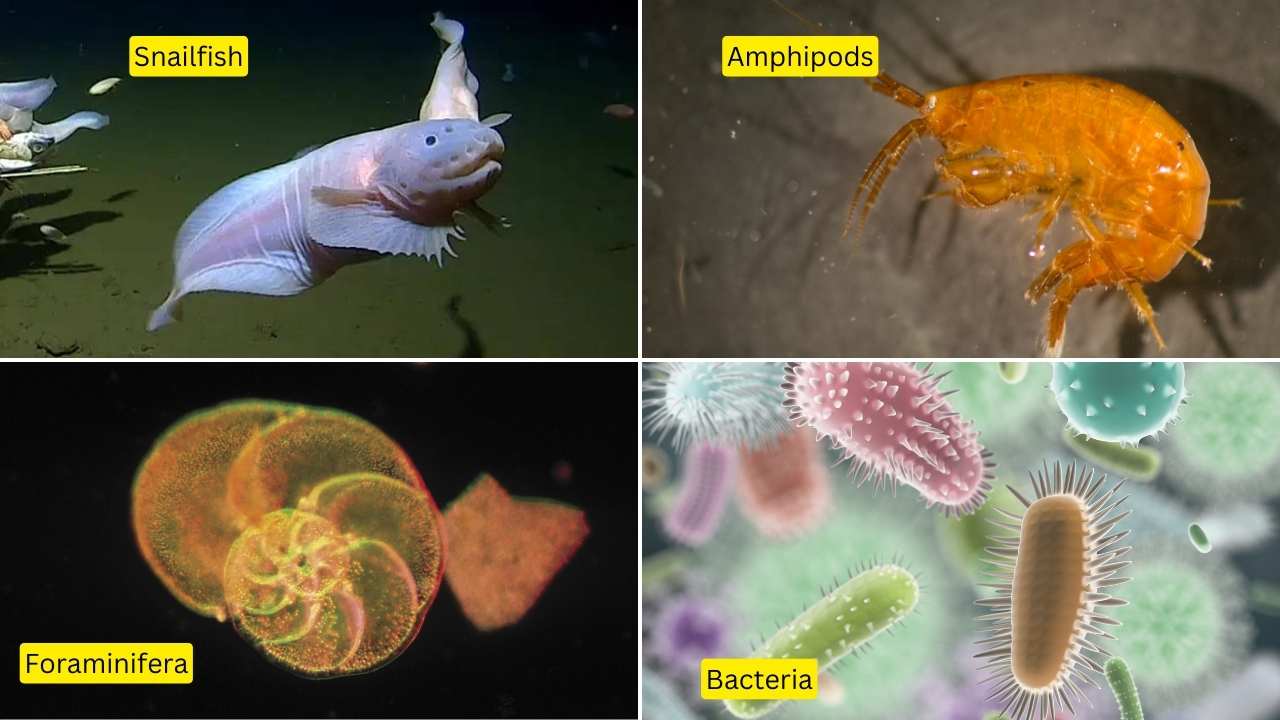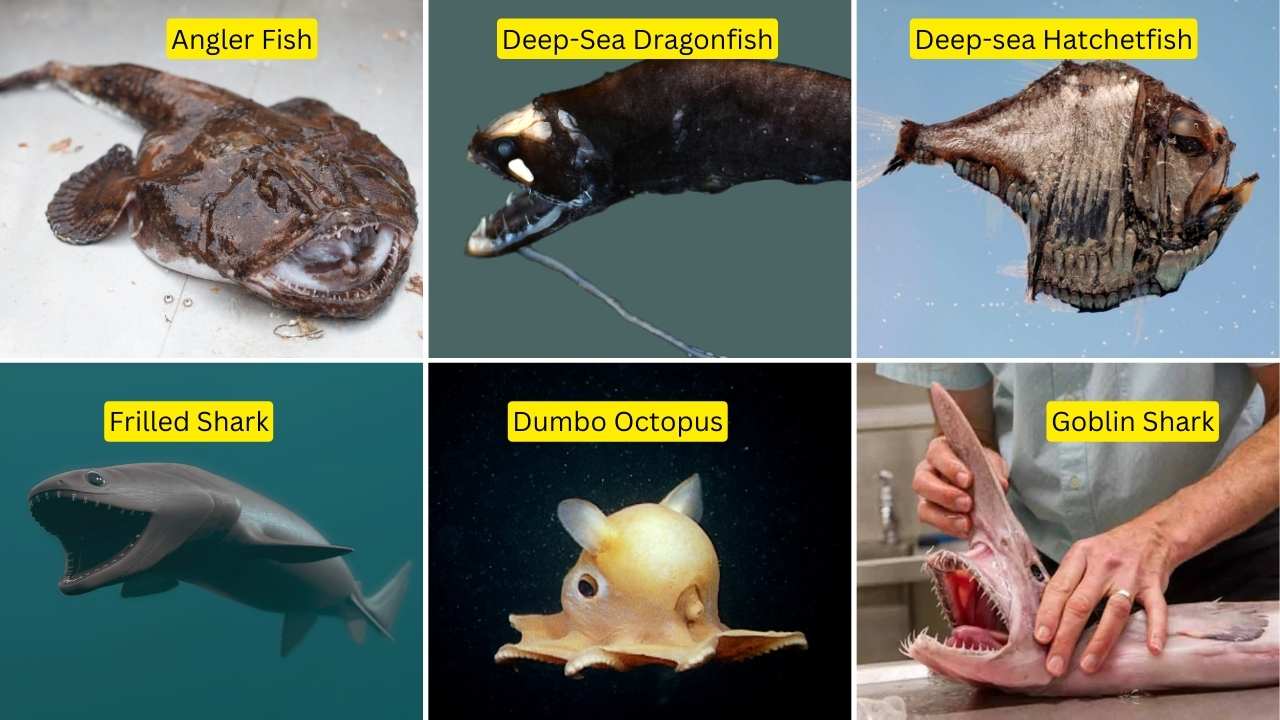The Mariana Trench is the deepest part of the ocean, which is found in the Pacific Ocean, plunging over 36,000 feet (11,1000 meters). It’s a mysterious and extreme environment where the pressure is crushing, and sunlight can’t reach. Despite these harsh conditions, life still finds its way out. In the Mariana Trench, unique creatures that have adapted to survive in the extreme environment are found. Some examples include amphipods, shrimp-like creatures, and the Mariana snailfish, which looks like a translucent fish. There are also giant single-celled organisms called xenophyophores, deep-sea jellyfish, squid, and various microbes. These creatures have developed special traits to live in the dark, cold, and high-pressure conditions of the trench.
What lives in Mariana Trench?

The ocean’s deepest parts are known as the halal zone. Mariana Trench is situated within this zone. Below are the diverse life forms residing in the Mariana Trench:
- Snailfish: It is the hadal zone’s most prevalent fish, snailfish are pink, slimy, and can grow up to a foot long.
- Amphipods: These tiny flea-like crustaceans are among the most abundant animals in the trench, coexisting with sea cucumbers.
- Foraminifera are large, single-celled organisms that are part of the trench’s complex ecosystems.
- Bacteria: Remarkably, bacteria thrive at densities ten times greater than those found on shallower ocean floors.
At these depths, no light from the surface can reach. As a result, many of the creatures residing in the hadal zone either lack vision or have very limited eyesight. Food sources are rare, typically consisting of the remains of dead animals that sink from the ocean’s upper layers. Most life forms here are scavengers or detritivores, meaning they feed on dead organic material and waste products.
What Animals Live In The Mariana Trench?

The Mariana Trench, the deepest part of the ocean, is home to a variety of unique creatures. Here are some of the animals that live in this extreme environment:
- Angler Fish
- Deep-Sea Dragonfish
- Deep-sea Hatchetfish
- Frilled Shark
- Dumbo Octopus
- Goblin Shark
These animals have adapted to survive in complete darkness, extreme pressure, and scarce food availability, making the Mariana Trench a unique and intriguing ecosystem.
Is there anything living in the Mariana Trench?

Despite the extreme conditions, various life forms have been discovered in the Mariana Trench. These organisms have adapted to the high pressure, low temperatures, and lack of sunlight. Some of the life forms found include:
- Xenophyophores
- Amphipods
- Holothurians
- Mariana Snailfish
These creatures are remarkable examples of life’s adaptability in some of the harshest environments on Earth.
🔬 Subscribe to SciMail
Get the latest science discoveries straight to your inbox!
Are there any fish in the deepest part of the ocean?
Yes, there are fish in the deepest parts of the Mariana Trench, like the Mariana snailfish (Pseudoliparis swirei). These fish have adapted to extreme conditions, such as crushing pressure and darkness, found at depths of up to about 8,000 meters (26,200 feet). Other species like cusk eels and grenadiers have also been observed in these depths.
What does it take for animals to survive in the Mariana Trench?

Animals in the Mariana Trench have developed remarkable adaptations to survive in such an extreme environment. Here are some of the key adaptations:
- Anatomical Structures: Some fish, like the Mariana snailfish, have gaps in their skulls and bones made largely of cartilage instead of hard bone, which helps them withstand immense pressure.
- Protein Stability: High levels of a substance called trimethylamine N-oxide (TMAO) help stabilize proteins against the pressure that could otherwise break them down.
- Genetic Adaptations: These creatures often have multiple copies of genes that help them cope with high pressure, like those for TMAO production.
- Cellular Function: They produce high numbers of proteins that transport necessary substances into and out of cells, a process that is challenging at high pressure.
- Sensory Adaptations: Due to complete darkness, some animals lack functional eyes or the genes necessary for light detection, as there’s no light to see.
Can you find plants in the Mariana Trench?
No, plants cannot grow in the Mariana Trench. The absence of sunlight at such extreme depths prevents photosynthesis, which is essential for plant life. The deepest parts of the ocean are in perpetual darkness, and the organisms that do live there rely on other means, like chemosynthesis, to survive.
Are there any new species being discovered in the Mariana Trench?

Yes, new species continue to be discovered in the Mariana Trench. For example, a shrimp-like species named Eurythenes plasticus was found between 6 and 7 kilometers down the trench. These discoveries are important for understanding the biodiversity and ecological processes of the deep ocean.
Do sharks live in the Mariana Trench?
No, sharks are not typically found in the Mariana Trench. The extreme depths and conditions of the trench are not suitable for most shark species. However, some species of deep-sea sharks may inhabit the upper layers of the ocean surrounding the trench, but they do not venture into its deepest parts.
What microbes live in the Mariana Trench?
The Mariana Trench hosts unique microbes that thrive on chemicals from the seafloor, including hydrocarbon-degrading bacteria like Oleibacter and Alcanivorax. These organisms suggest active biological processes in deep sea environments.


Leave a Reply